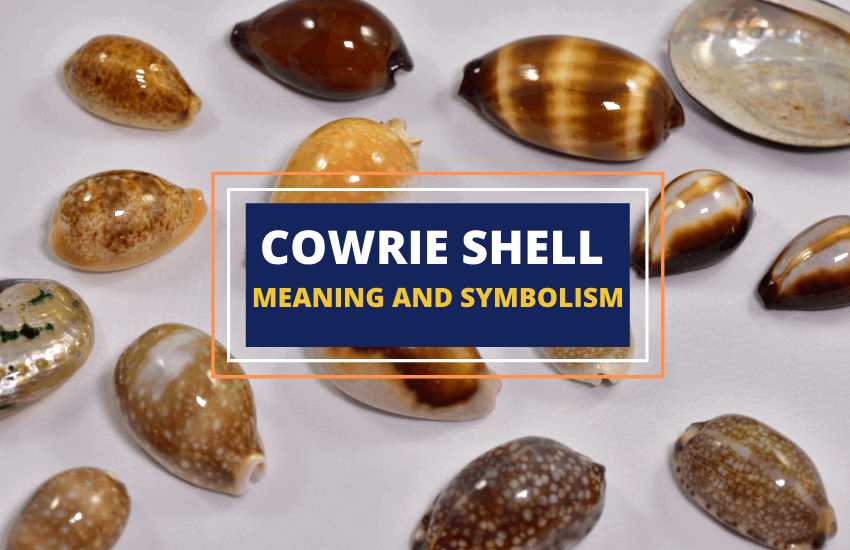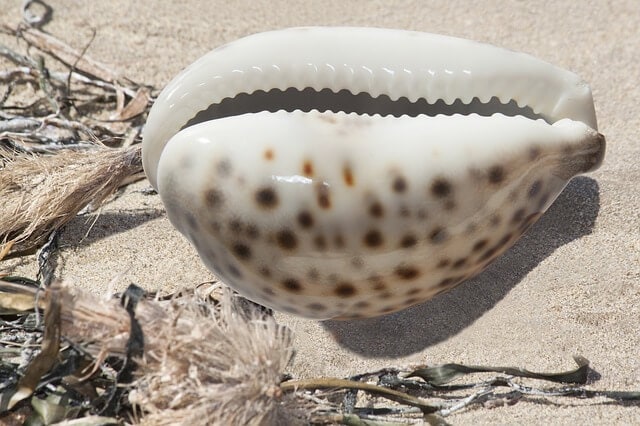
Table of Contents
Cowrie Shells might appear simple and unassuming, but they are highly valued, and in some parts of the world, have even been used as jewelry and currency. Cowrie Shells are admired for their delicate shells and markings and have been an integral part of many ancient cultures, traditions, and belief systems.
What is a Cowrie Shell?

The word Cowrie or Cowry comes from the Sanskrit word kaparda which means small shell. The term is generally used to classify marine snails and gastropod mollusks. Cowries are predominantly found in coastal areas, particularly in the Indian and Pacific oceans.
The old Italian word for Cowrie Shells Porcellana, was the root for the English word Porcelain. The English included the word in their vocabulary due to the similarity between Cowrie Shells and porcelain ceramic.
Characteristics of Cowrie Shells
Cowrie Shells have a smooth, shiny, and glossy surface. They are predominantly shaped and structured like an egg. The round part of the shell, or what looks like its back, is called the Dorsal Face. The flat side of the shell, with an opening in its middle, is called the Ventral Face.
Almost all Cowrie Shells glow and shine similar to porcelain ceramic. Most varieties of shells are also etched with colorful patterns and designs. Cowrie Shells can be anywhere between 5mm to 19 cm long, depending on the species.
Cowrie Shells in Culture
Cowrie Shells have been used as currency, jewelry, and sacred objects in many cultures.
Let’s take a look at the meaning of Cowrie Shells in ancient civilizations.
1. Africa
African trade networks used Cowrie Shells as their main form of currency. Due to their lightweight nature, they could be easily placed on strings and transported across the continent. Cowrie Shells were also easy to handle, protect, and count.
Cowrie Shells were always prevalent in Africa, but they became widespread only after the entry of European colonizers. The Europeans introduced large numbers of Cowrie Shells and exchanged them for both slaves and gold.
2. China
The Ancient Chinese used Cowrie Shells as a form of currency, and they eventually became a Chinese Character to represent money. In China, there was a large demand for Cowrie Shells and over the years they became very scarce. Due to this reason, people began making imitations of Cowries from bones and other materials. Cowrie Shells were also placed in tombs, for the dead to have access to wealth.
3. India
In Southern India, Cowrie Shells were used by astrologers to predict and foresee the future. The astrologer would hold Cowrie Shells in his palms and rub them together in a ritualistic chant. After this, a certain number of Cowrie Shells were taken up and kept separately. From this separated bundle, a few shells were picked based on logic and calculation. The remaining shells were finally used for predicting and foreseeing the future.
4. North America
Ancient North American tribes like the Ojibway, used Cowrie Shells as sacred objects. The shells were often used in Midewiwin ceremonies, that promoted spiritual growth and healing. It remains a mystery how the Ojibway discovered Cowrie Shells since their homes were far away from the ocean.
Uses of Cowrie Shells
Cowrie Shells weren’t only used for monetary purposes by ancient civilizations, but also as jewelry and for decoration. The Chinese used Cowrie Shells on their clothes to make them look appealing and attractive.
African women wore accessories made of Cowrie Shells and even decorated their hair and attire with them. Masks were made from Cowrie Shells for dances and celebrations. They were also placed on sculptures, baskets, and other everyday objects. Warriors and hunters glued Cowrie Shells onto their outfits for greater protection.
In contemporary times, Cowrie Shells are used to make unique jewelry, art, and craft items.
Types of Cowrie Shells
- Yellow Cowrie: Yellow Cowrie Shells have a yellow shade and are used for prosperity and wealth. They are also kept to balance the mystical powers of planet Jupiter.
- Tiger Cowrie: Tiger Cowrie Shells have a mound that resemble the pattern of a tiger’s skin. These shells are used to keep away negative energy and ward off the evil eye.
- White Cowrite: White Cowrie Shells are the most common and popular variety. They are used for astrological purposes and are believed to contain divine powers.
Symbolic Meanings of Cowrie Shells
Cowrie Shells have various symbolic meanings, which add to their value. This varies from region to region, but there are some similarities that can be found across cultures.
- Symbol of Fertility: In African tribes, such as the Mende of Sierra Leone, Cowrie Shells were symbols of womanhood, fertility, and birth. The split in the shell was seen as a symbol of the vulva and called the Giver or Elixir of life.
- Symbol of Rank: In the Fiji Islands, golden Cowrie Shells were used by the chieftains of tribes as a symbol of rank and prestige.
- Symbol of Prosperity: In both African and American cultures, Cowrie Shells were an emblem of wealth and prosperity. Those who had more Cowrie Shells were considered affluent and given respect and honor.
- Symbol of Protection: Cowrie Shells were closely associated with the African goddess of protection who resided in the ocean, Yemaya. Those who adorned these shells were blessed and protected by the deity.
In Brief
Cowrie Shells have a plethora of symbolic meanings, and they are intricately connected with many ancient civilizations. While these objects may no longer hold as much value as in the past, they’re still admired and used for their beauty and versatility.








